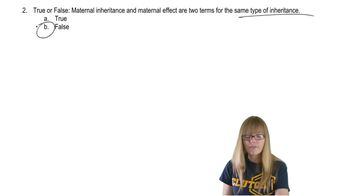- 1. Introduction to Genetics51m
- 2. Mendel's Laws of Inheritance3h 37m
- 3. Extensions to Mendelian Inheritance2h 41m
- 4. Genetic Mapping and Linkage2h 28m
- 5. Genetics of Bacteria and Viruses1h 21m
- 6. Chromosomal Variation1h 48m
- 7. DNA and Chromosome Structure56m
- 8. DNA Replication1h 10m
- 9. Mitosis and Meiosis1h 34m
- 10. Transcription1h 0m
- 11. Translation58m
- 12. Gene Regulation in Prokaryotes1h 19m
- 13. Gene Regulation in Eukaryotes44m
- 14. Genetic Control of Development44m
- 15. Genomes and Genomics1h 50m
- 16. Transposable Elements47m
- 17. Mutation, Repair, and Recombination1h 6m
- 18. Molecular Genetic Tools19m
- 19. Cancer Genetics29m
- 20. Quantitative Genetics1h 26m
- 21. Population Genetics50m
- 22. Evolutionary Genetics29m
17. Mutation, Repair, and Recombination
Types of Mutations
Problem 12d
Textbook Question
Why are X rays more potent mutagens than UV radiation?
 Verified step by step guidance
Verified step by step guidance1
X-rays and UV radiation are both forms of electromagnetic radiation, but they differ in their energy levels.
X-rays have a much shorter wavelength than UV radiation, which means they have higher energy.
Higher energy levels allow X-rays to penetrate deeper into biological tissues and cause more significant damage to DNA.
X-rays can cause double-strand breaks in DNA, which are more difficult for the cell to repair accurately compared to the single-strand breaks or thymine dimers typically caused by UV radiation.
The greater potential for causing complex DNA damage makes X-rays more potent mutagens than UV radiation.
Recommended similar problem, with video answer:
 Verified Solution
Verified SolutionThis video solution was recommended by our tutors as helpful for the problem above
Video duration:
2mPlay a video:
Was this helpful?
Key Concepts
Here are the essential concepts you must grasp in order to answer the question correctly.
Mutagenesis
Mutagenesis refers to the process by which genetic information is changed, resulting in mutations. Mutagens are agents that cause these changes, and they can be physical, chemical, or biological. Understanding how different types of radiation, like X-rays and UV light, induce mutations is crucial for evaluating their potency as mutagens.
Recommended video:
Guided course

Induced Mutations
Types of Radiation
Radiation can be classified into ionizing and non-ionizing types. X-rays are a form of ionizing radiation, which means they have enough energy to remove tightly bound electrons from atoms, leading to DNA damage. In contrast, UV radiation is non-ionizing and primarily causes damage through the formation of pyrimidine dimers, which are less severe than the breaks caused by ionizing radiation.
Recommended video:
Guided course

Types of Maternal Inheritance
DNA Repair Mechanisms
Cells have evolved various DNA repair mechanisms to fix damage caused by mutagens. These include nucleotide excision repair for UV-induced damage and double-strand break repair for ionizing radiation like X-rays. The efficiency and accuracy of these repair processes can influence the overall mutagenic potential of different types of radiation, making it essential to understand their roles in cellular responses to DNA damage.
Recommended video:
Guided course

Repair Pathways

 9:49m
9:49mWatch next
Master Point Mutations with a bite sized video explanation from Kylia Goodner
Start learning



